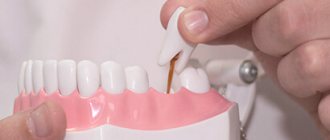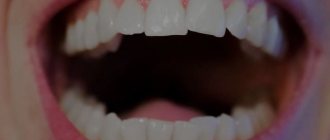Pulpotomy (partial amputation of the pulp) is a dental operation that acts as a method of treating pulpitis.
Pulpitis is an inflammatory process that occurs inside the tooth under the enamel and dentin - in the pulp.
As a result of a pulpotomy, part of the pulp located in the crown of the tooth is removed. The root part of the pulp is preserved.
In modern dental practice, two methods of pulpotomy are used - vital and devital. The latter method is less popular and is used much less frequently than the first.
The vital method of pulpotomy allows you to keep that part of the pulp that is in the root canal viable. However, if the pulp in the coronal part is very damaged, then it is possible to remove some of the coronal pulp - all infected tissue is amputated to the border of viable tissue. This procedure is called "high amputation".
Devital pulpotomy
The devital pulpotomy method is used in the case of elderly patients with already overgrown root canals or if the patient suffers from severe somatic pathology. To do this, open the pulp chamber and put a drug into the hole that kills the pulp. The dead pulp is then removed down to the border of the root canal. A product is applied that mummifies the root part, after which a special gasket is placed and the hole in the tooth is filled. In this case, pulpotomy is performed as a barrier method to prevent the inflammation process from spreading to periodontal tissue.
What is the difference between baby tooth pulpotomy and pulpectomy?
In many cases, patients confuse these two procedures, especially because they are similar terms. A pulpectomy is a treatment that goes beyond a pulpotomy and can be considered a root canal treatment for baby teeth. That is, it consists in completely emptying the pulp cavity of the tooth if pulpotomy of primary teeth is not sufficient to save the tooth.
In our clinic, specialists perform pulpotomy in children. Professionals solve the problem quickly and prevent complications from developing. Make an appointment today.
Vital pulpotomy
Typically, vital pulpotomy is performed on children, since the root part of the pulp will continue to grow and develop after the procedure. Adults undergo conservative treatment, which involves removing the entire infected pulp (even if it is still alive) followed by filling the root canal. It is considered irrational to preserve the root part of the pulp when root growth has already completed.
It is worth noting that this type of treatment is carried out not only on those teeth where the coronal and root parts of the pulp are clearly differentiated and have a pronounced boundary - these are molars and premolars. For those teeth where there is no clear transition point from the crown to the root, pulpotomy is performed along the cement-enamel boundary.
Indications for pulpotomy
It is not recommended to perform on mature permanent teeth, since enucleation of the pulp from the canals and their dense filling has become the standard. This procedure gives much better results and reduces the risk of complications such as pulp infection.
In the case of permanent teeth with incomplete root development, there are some (albeit limited) indications for surviving amputation. Then the procedure is sometimes considered as temporary: later, after it has been carried out, classical root canal treatment is recommended. Currently, pulpotomy is performed on primary molars.
Indications for the procedure are most often reversible and asymptomatic pulpitis, that is, teeth with carious or mechanical pulp exposure without pathological clinical symptoms such as swelling, fistulas, pathological reactions to percussion or purulent pulp exudate.
Why is this procedure used for primary molars rather than conventional treatment. It's connected with:
- difficulties with the correct development and filling of the often complex system of canals;
- fear of damaging the permanent tooth germ;
- a relatively short period of time when baby teeth are in the mouth.
Thus, vital pulpotomy of primary teeth is mainly performed for safety reasons.
The most common filling materials used for direct pulp capping are calcium hydroxide, metal trioxide conglomerate - a newer but more expensive material), formocresol, or adhesive resin (a resin-based binder that is applied directly to the dental nerve).
After pulpotomy, one of the following four filling materials is used: ferrous sulfate, formocresol, calcium hydroxide, or trioxide conglomerate.
After the procedure, the cavity after removing the pulp is filled with a bandage. This medication should not interfere with the root absorption of baby teeth to allow permanent teeth to grow.
Prediction of treatment success
Vital pulpotomy is a fairly reliable procedure if the goal is to preserve at least part of the pulp functional. However, the success of such treatment largely depends on the dentist’s ability to determine how deep the infection has gone. In other words, the doctor is faced with the task of accurately establishing whether the pulpitis has affected only the coronal part or has spread to the root area of the pulp. Often, a dentist skilled in clinical research methods can confidently determine the boundaries of infection only in 50-60% of cases. Thus, pulpotomy cannot be considered an absolutely definitive treatment. And at the same time, as a method of temporary treatment, pulpotomy is still appropriate, especially since the chances that the pulp will remain at least partially viable are quite high. In the case of pulpitis treatment in children, the vital pulpotomy method is a priority, since the process of root formation is very important.
Step-by-step pulpotomy in children
To determine whether a patient requires a simple filling or a more effective treatment such as a pulpotomy, the first thing to do is contact a reputable clinic. There, the pediatric dentist will be able to assess the status and severity of the injury by using a dental x-ray to check the extent of the damage caused by the pulpitis.
A pulpotomy is not exactly equivalent to a root canal because only the diseased tissue is removed, not all of it, including healthy tissue. To perform it, it is necessary to apply local anesthesia to the patient in order to avoid discomfort during the intervention.
This treatment does not in any way affect the subsequent eruption of the permanent tooth, but it does prevent premature loss of a baby tooth, as well as other complications.
Pulpotomy of a baby tooth involves removing the pulp of the ventricles while preserving the pulp in the canals. The procedure can be represented in several main stages:
- administration of local anesthesia;
- removal of root canal pulp;
- stop bleeding with sterile cotton balls;
- removing pulp;
- coating the bottom of the channel with zinc oxide with eugenol;
- filling the cavity.
In addition, regular checkups at the dentist's office, during which dental x-rays are taken, are very important. The procedure is considered successful if the tissues surrounding the tooth are normal (both by visual examination and by x-ray examination) and the process of physiological root resorption is not disturbed.
There is also a complete pulpotomy in children, which is sometimes performed in children and adolescents seeking dental treatment due to deep caries complicated by irreversible pulpitis.
After the procedure, the specialist will conduct further examinations of the patient to monitor his condition. Thus, even if any complications arise - the formation of a cyst, persistent inflammation, the presence of fistulas and other problems - they can be resolved in a timely manner.
Pulpotomy process
The method of performing vital pulpotomy is that the process is divided into two stages and is performed in two visits to the dentist with a break of 6 months. The first stage of vital pulpotomy:
- After anesthetizing the desired area, a layer of enamel and affected dentin is removed using a drill.
- The pulp area is then opened and the infected portion is removed, usually at the level of the root canal orifice.
- The bleeding is stopped and a drug is applied, which serves as a therapeutic dressing for the remaining part of the pulp.
- Lastly, a temporary filling is placed.
After this procedure, the dentist closely monitors the operated tooth for six months. Monitors for any negative manifestations that indicate that the pulpotomy was ineffective. If there is no pain or changes in the jawbone, the pulpotomy is considered successful and a permanent filling can be installed.
Vital pulpotomy is considered an effective procedure, but it should be performed in the initial stages of pulpitis. In order not to risk starting the inflammatory process to an irreversible level, when this treatment procedure will no longer help preserve the pulp of a child’s tooth, it is necessary to regularly visit the dentist with the child. The specialist will be able to notice the problem in time and begin treatment immediately.
Pulpotomy in pediatric dentistry
A pulpotomy is a dental procedure in which the pulp in the crown (the visible part of the tooth) is removed while the pulp in the root canal is left intact. Mainly performed on baby teeth (in children), when caries has affected the pulp.
If a child complains of pain when cold, hot or sweet substances touch the tooth/teeth, this is one of the signs of pulpitis. Pulpitis is an inflammation of the pulp, and its main cause is untreated caries.
This tooth sensitivity is usually the first sign that a child has tooth decay.
The dentist will recommend a pulpotomy if, after examining the teeth, he finds caries that has affected the pulp in the crown. The examination is carried out by physical examination of the tooth or x-ray.
If it is discovered that the child has irreversible pulpitis caused by tooth decay, when the pulp in the tooth is severely damaged, the pulpotomy is canceled. Instead, a pulpectomy or tooth extraction is performed.
A pulpotomy is performed when a child has serious physical trauma to a tooth. Pulpotomy is performed to preserve the root of the tooth and the pulp in it.
Why is the affected tooth not removed?
The reason is that the primary tooth ensures that proper space and sufficient space is maintained for the growth of the permanent tooth.
Literally, “pulpotomy” translates as “cutting the pulp.” However, in the medical community, the term refers to the entire procedure, including filling the space from which the pulp is removed with medication.
Pulpotomy is usually performed on primary teeth, but can also be performed successfully on permanent teeth.
A pulpotomy is not to be confused with a pulpectomy, which is done when tooth decay extends beyond the pulp at the crown to the pulp at the root of the tooth (radicular pulp).
Risks and contraindications
Pulpotomy is a safe procedure without serious risks. The procedure is not performed if the pulp at the root (radicular pulp) has died. This means that the pulp must be free of infection and healthy at the time of the procedure.
How long does a pulpotomy last?
The patient remains in the dental chair for 30 to 45 minutes, in some cases a little longer.
Where do they make it?
The procedure takes place in the dentist's office.
What to wear
Since this is a dental procedure, the child is dressed in any comfortable clothing.
What do they take with them?
If your child has a toy that will be comforting after the procedure, take it with you.
What does a dentist do?
The dentist numbs the area around the tooth with a local anesthetic, then injects the anesthesia into the gums. In addition, the child may be given a sedative. The option is at the discretion of the doctor.
The dentist finds the tooth to be treated, removes caries, and prevents infection of the pulp.
The pulp chamber is opened by drilling through the enamel and dentin and it bleeds, this shows that the pulp is healthy. If the pulp chamber is filled with pus or is empty and dry, the dentist will not proceed with the pulpotomy or perform a pulpectomy or tooth extraction.
The pulp in the crown is then removed/extracted. Once this is done, moist cotton swabs are used to stop the bleeding and clean the area. Ideally, bleeding stops within a minute or two, five at most. All dentists have their own time constraints.
If bleeding does not stop after this time, it indicates that the pulp is fundamentally unhealthy and is likely affected by decay. In this case, a pulpectomy or tooth extraction is performed.
As soon as the bleeding has stopped, the radicular pulp is treated with medicinal preparations of the dentist’s choice:
- formocresol;
- ferrous sulfate;
- mineral trioxide aggregate.
After this, the pulp chamber of the tooth is sealed with zinc oxide eugenol cement or other material. Then the tooth is restored. This is usually done with a stainless steel crown.
After the procedure
The child may experience pain and/or gum swelling after the procedure. The doctor will most likely prescribe a pain reliever.
The dentist will provide instructions on the types and temperatures of foods the child eats for several days after the procedure. Your doctor will likely advise you to avoid eating candy or other sticky foods until the stainless steel crown used to restore the tooth falls out.
To prevent other teeth from becoming damaged by caries:
- take care of your oral cavity;
- ask your dentist for dental care recommendations;
- Visit your dentist regularly.
Conclusion
It is natural to feel anxious when a child undergoes any medical procedure. Pulpotomy is performed without risks. The child will return to normal activities after the anesthesia or sedative used during the procedure wears off. If you have any questions or concerns, discuss them with your dentist.
Partial or complete pulp removal
In dentistry, two methods are used to treat pulpitis: vital pulpotomy and pulpectomy. The second method involves complete removal of the pulp, but pulpectomy is rarely used in pediatric dentistry.
Vital pulpotomy is aimed at preserving the viable part of the pulp located in the root canal. In case of extensive damage, the coronal part can be removed to the borders of the “living” tissue. The advantage of this technique in pediatric dentistry is the ability of the pulp of primary teeth to continue to develop and grow. For an effective result, it is important that the periapical root is not severely damaged.
Complete pulp removal is not performed for safety reasons. As a result of depulpation, damage to the tooth buds, disruption of the root canal system, or the development of complications due to the not yet formed dental system may occur. For these reasons, when there is pulpitis in primary teeth, dentists decide to remove the tooth or perform a vital pulpotomy. In case of pulpitis of a permanent tooth, a pulpectomy is performed.
Pulpitis and pulpotomy
Many people believe that a baby tooth only has a crown and roots. This statement is absolutely false. Just like an adult’s, a child’s tooth has a pulp, which is an internal tissue supplied with nerve endings and blood vessels. It is the pulp that is responsible for the “nutrition” of the tooth and its sensitivity.
Pulpitis is common in children. This is a process of inflammation of the pulp that can cause serious pain, prompting an urgent visit to dentistry. Pulpitis develops in most cases against the background of deep caries, but there may be other reasons.
Treatment of pulpitis at the initial stage is quick and does not require any serious manipulation. If the pulp is severely damaged, treatment will consist of partial or complete removal of the dental nerve and infected tissue.
Pulpotomy is a procedure for partial removal of pulp in order to preserve the tooth and its “vitality”. With complete amputation, the tooth will no longer receive nutrition, lose sensitivity and may gradually collapse.
In pediatric dentistry, pulpotomy is often used, since premature tooth loss can be fraught with negative consequences. Modern methods of anesthesia and treatment allow the procedure to be performed quickly and painlessly.










